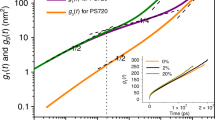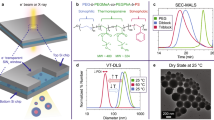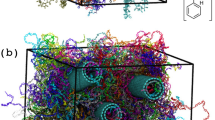Abstract
In a previous article, we proposed a surface-controlled cooperatively rearranging region (SCC) model that mimics the segmental dynamics of supercooled liquids, including polymeric materials. By introducing surface/interface effects into the SCC model, the size-dependent dynamics of nanosized polymer materials such as ultrathin films can be predicted. In this study, the SCC model is extended to various nanomaterial geometries, i.e., filled fibers (cylinders), filled spheres, hollow fibers, hollow spheres, core/shell fibers, core/shell spheres, and thin films and spheres embedded in a substrate. We formulated temperature-dependent hole (free-volume) fraction profiles with respect to local position in the nanomaterials, and evaluated the weighted average of the hole fraction to consider the coupled dynamics in nanoconfined systems. The predicted glass transition temperature (Tg) and fragility (m) of filled spheres of polystyrene coincide qualitatively with experimental observations reported in literature. The geometry dependence of the dynamics was also investigated, and it was revealed that Tg (filled sphere) > Tg(filled fiber) > Tg (free-standing film) when compared at the same surface area to volume ratio, whereas for fragility, the opposite trend was found, i.e., m (free-standing film) > m (filled fiber) > m (filled sphere).
This is a preview of subscription content, access via your institution
Access options
Subscribe to this journal
Receive 12 print issues and online access
$259.00 per year
only $21.58 per issue
Buy this article
- Purchase on Springer Link
- Instant access to full article PDF
Prices may be subject to local taxes which are calculated during checkout








Similar content being viewed by others
References
Napolitano S, Glynos E, Tito NB. Glass transition of polymers in bulk, confined geometries, and near interfaces. Rep Prog Phys. 2017;80:036602.
Priestley RD, Ellison CJ, Broadbelt LJ, Torkelson JM. Structural relaxation of polymer glasses at surfaces, interfaces, and in between. Science. 2005;309:456–9.
Akabori K, Tanaka K, Nagamura T, Takahara A, Kajiyama T. Molecular motion in ultrathin polystyrene films: Dynamic mechanical analysis of surface and interfacial effects. Macromolecules. 2005;38:9735–41.
Stevenson JD, Wolynes PG. On the surface of glasses. J Chem Phys. 2008;129:234514.
Ediger MD, Forrest JA. Dynamics near free surfaces and the glass transition in thin polymer films: A view to the future. Macromolecules. 2014;47:471–8.
Keddie JL, Jones RAL, Cory RA. Size-dependent depression of the glass transition temperature in polymer films. Europhys Lett. 1994;27:59–64.
Keddie JL, Jones RAL, Cory RA. Interface and surface effects on the glass-transition temperature in thin polymer films. Faraday Disc. 1994;98:219–30.
Efremov MY, Olson EA, Zhang M, Zhang Z, Allen LH. Probing glass transition of ultrathin polymer films at a time scale of seconds using fast differential scanning calorimetry. Macromolecules. 2004;37:4607–16.
Koh YP, McKenna GB, Simon SL. Calorimetric glass transition temperature and absolute heat capacity of polystyrene ultrathin films. J Polym Sci B Polym Phys. 2006;44:3518–27.
Fukao K, Miyamoto Y. Glass transitions and dynamics in thin polymer films: dielectric relaxation of thin films of polystyrene. Phys Rev E. 2000;61:1743–54.
Forrest JA, Dalnoki-Veress K. When does a glass transition temperature not signify a glass transition? ACS Macro Lett. 2014;3:310–4.
Priestley RD, Cangialosi D, Napolitano S. On the equivalence between the thermodynamic and dynamic measurements of the glass transition in confined polymers. J Non-Cryst Solids. 2015;407:288–95.
Debenedetti PG, Stillinger FH. Supercooled liquids and the glass transition. Nature 2001;410:259–67.
Lappala A, Sefton A, Fenimore PW, Terentjev EM. Connectivity and free-surface effects in polymer glasses. Sci Rep. 2019;9:3830.
Chandran S, Baschnagel J, Cangialosi D, Fukao K, Glynos E, Janssen LMC, et al. Processing pathways decide polymer properties at the molecular level. Macromolecules. 2019;52:7146–56.
Adam G, Gibbs JH. On the temperature dependence of cooperative relaxation properties in glass-forming liquids. J Chem Phys. 1965;43:139–46.
Lubchenko V, Wolynes PG. Theory of structural glasses and supercooled liquids. Annu Rev Phys Chem. 2007;58:235–66.
Sato A, Sasaki T. Cooperativity of dynamics in supercooled polymeric materials and its temperature dependence predicted from a surface controlled model. Eur Polym J. 2018;99:485–94.
Sasaki T, Nakane T, Sato A. Segmental dynamics of free-standing and supported polymer thin films predicted from a surface-controlled model. Polymer. 2019;172:265–71.
Paeng K, Swallen SF, Ediger MD. Direct measurement of molecular motion in freestanding polystyrene thin films. J Am Chem Soc. 2011;133:8444–7.
Gauer U, Wunderlich B. Study of microphase separation in block copolymers of styrene and α-methylstyrene in the glass transition region using quantitative thermal analysis. Macromolecules. 1980;13:1618–25.
Ding J, Xue G, Dai Q, Cheng R. Glass transition temperature of polystyrene microparticles. Polymer. 1993;34:3325–7.
Sasaki T, Shimizu A, Mourey TH, Thurau CT, Ediger MD. Glass transition of small polystyrene spheres in aqueous suspensions. J Chem Phys. 2003;119:8730–5.
Zhang C, Guo Y, Priestley RD. Glass transition temperature of polymer nanoparticles under soft and hard confinement. Macromolecules. 2011;44:4001–6.
Guo Y, Zhang C, Lai C, Priestley RD, D’Acunzi M, Fytas G. Structural relaxation of polymer nanospheres under soft and hard confinement: Isobaric versus isochoric conditions. ACS Nano. 2011;5:5365–73.
Zhang C, Guo Y, Shepard KB, Priestley RD. Fragility of an isochorically confined polymer glass. J Phys Chem Lett. 2013;4:431–6.
Zhang C, Boucher VM, Cangialosi D, Priestley RD. Mobility and glass transition temperature of polymer nanospheres. Polymer. 2013;54:230–5.
Kim H, Cang Y, Kang E, Graczykowski B, Secchi M, Montagna M, et al. Direct observation of polymer surface mobility via nanoparticle vibrations. Nat Commun. 2018;9:2918.
Sasaki T, Kawagoe S, Mitsuya H, Irie S, Sakurai K. Glass transition of crosslinked polystyrene shells formed on the surface of calcium carbonate whisker. J Polym Sci B Polym Phys. 2006;44:2475–85.
Sasaki T, Misu M, Shimada T, Teramoto M. Glass transition and its characteristic length for thin crosslinked polystyrene shells of rodlike capsules. J Polym Sci B Polym Phys. 2008;46:2116–25.
Sasaki T, Kuroda R, Teramoto M, Yonezawa S, Tsuji H, Sakurai K, et al. Glass transition properties of PMMA thin shells deposited on rodlike calcium carbonate particles. Polym J. 2011;43:464–70.
Sasaki T, Suzuki K, Yonezawa S, Irie S, Sakurai K. Preparation and glass transition of crosslinked poly(vinyl acetate) thin shells on the surface of a calcium carbonate core. Polym J. 2011;43:881–6.
Kang E, Graczykowski B, Jonas U, Christie D, Gray LAG, Cangialosi D, et al. Shell architecture strongly influences the glass transition, surface mobility, and elasticity of polymer core-shell nanoparticles. Macromolecules. 2019;52:5399–406.
Bares J. Glass transition of the polymer microphase. Macromolecules. 1975;8:244–6.
McKenna GB. Confit III summary and perspectives on dynamics in confinement. Eur Phys J Spec Top. 2007;141:291–301.
Rharbi Y. Reduction of the glass transition temperature of confined polystyrene nanoparticles in nanoblends. Phys Rev E. 2008;77:031806.
Robertson CG, Hogan TE, Rackaitis M, Puskas JE, Wang X. Effect of nanoscale confinement on glass transition of polystyrene domains from self-assembly of block copolymers. J Chem Phys. 2010;132:104904.
Stevenson JD, Schmalian J, Wolynes PG. The shapes of cooperatively rearranging regions in glass-forming liquids. Nat Phys. 2006;2:268–74.
Salez T, Salez J, Dalnoki-Veress K, Raphael E, Forrest JA. Cooperative strings and glassy interfaces. Proc Natl Acad Sci. 2015;112:8227–31.
Arutkin M, Raphael E, Forrest JA, Salez T. Cooperative strings in glassy nanoparticles. Soft Matter. 2017;13:141–6.
Napolitano S, Wubbenhorst M. The lifetime of the deviations from bulk behaviour in polymers confined at the nanoscale. Nat Commun. 2011;2:260.
Sun S, Xu H, Han J, Zhu Y, Zuo B, Wang X, et al. The architecture of the adsorbed layer at the substrate interface determines the glass transition of supported ultrathin polystyrene films. Soft Matter. 2016;12:8348–58.
Braatz ML, Meléndez LI, Sferrazza M, Napolitano S. Unexpected impact of irreversible adsorption on thermal expansion: Adsorbed layers are not that dead. J Chem Phys. 2017;146:203304.
Zuo B, Wang F, Hao Z, He H, Zhang S, Priestley RD, et al. Influence of the interfacial effect on polymer thin-film dynamics scaled by the distance of chain mobility suppression by the substrate. Macromolecules. 2019;52:3753–62.
Wittmann JC, Kovacs AJ. Influence de la Stereorégularite des chaînes sur les transitions du polyméthacrylate de méthyle. J Polym Sci C. 1967;16:4443–52.
Saito S. Temperature dependence of dielectric relaxation behavior for various polymer systems. Colloid Polym Sci. 1963;189:116–25.
Capaccioli S, Ruocco G, Zamponi F. Dynamically correlated regions and configurational entropy in supercooled liquids. J Phys B. 2008;112:10652–58.
Paeng K, Ediger MD. Molecular motion in free-standing thin films of poly(methyl methacrylate), poly(4-tert-butylstyrene), poly(α-methylstyrene), and poly(2-vinylpyridine). Macromolecules. 2011;44:7034–42.
Fryer DS, Nealey PF, de Pablo JJ. Thermal probe measurements of the glass transition temperature for ultrathin polymer films as a function of thickness. Macromolecules. 2000;33:6439–47.
Fryer DS, Peters RD, Kim EJ, Tomaszewski JE, de Pablo JJ, Nealey PF, et al. Dependence of the glass transition temperature of polymer films on interfacial energy and thickness. Macromolecules. 2001;34:5627–34.
Roth CB, Pound A, Kamp SW, Murray CA, Dutcher JR. Molecular-weight dependence of the glass transition temperature of freely-standing poly(methyl methacrylate) films. Eur Phys J E. 2006;20:441–8.
Mattsson J, Forrest JA, Borjesson L. Quantifying glass transition behavior in ultrathin free-standing polymer films. Phys Rev E. 2000;62:5187–200.
Boucher VM, Cangialosi D, Yin H, Schonhals A, Alegria A, Colmenero J. Tg depression and invariant segmental dynamics in polystyrene thin films. Soft Matter. 2012;8:5119–22.
Martínez-Tong DE, Soccio M, Sanz A, García C, Ezquerra TA, Nogales A. Chain arrangement and glass transition temperature variations in polymer nanoparticles under 3D-confinement. Macromolecules. 2013;46:4698–705.
Pressly J, Riggleman RA, Winey KI. Increased polymer diffusivity in thin-film confinement. Macromolecules. 2019;52:6116–25.
Li S, Ding M, Shi T. Spatial distribution of entanglements and dynamics in polymer films confined by smooth walls. Polymer. 2019;172:365–71.
Hanakata PZ, Douglas JF, Starr FW. Local variation of fragility and glass transition temperature of ultra-thin supported polymer films. J Chem Phys. 2012;137:244901.
Hanakata PZ, Betancourt BAP, Douglas JF, Starr FW. A unifying framework to quantify the effects of substrate interactions, stiffness, and roughness on the dynamics of thin supported polymer films. J Chem Phys. 2015;142:234907.
Zhang W, Starr FW, Douglas JF. Collective motion in the interfacial and interior regions of supported polymer films and its relation to relaxation. J Phys Chem B. 2019;123:5935–41.
Acknowledgements
This work was supported by JSPS KAKENHI Grant Number JP16K05907 from the Ministry of Education, Culture, Sports, Science and Technology of Japan.
Author information
Authors and Affiliations
Contributions
TS designed and supervised the research. TN carried out the calculations. YT supported the calculations. TN and TS wrote the paper.
Corresponding author
Ethics declarations
Conflict of interest
The authors declare that they have no conflict of interest.
Additional information
Publisher’s note Springer Nature remains neutral with regard to jurisdictional claims in published maps and institutional affiliations.
Supplementary information
Rights and permissions
About this article
Cite this article
Nakane, T., Tsuzuki, Y. & Sasaki, T. Glass transition and fragility of nanosized polymeric fibers and spheres predicted from a surface-controlled model. Polym J 53, 363–372 (2021). https://doi.org/10.1038/s41428-020-00431-5
Received:
Revised:
Accepted:
Published:
Issue Date:
DOI: https://doi.org/10.1038/s41428-020-00431-5
This article is cited by
-
DSC investigation of chain cooperativity rearrangements and critical length scale of polybutadiene networks in glass transition range
Journal of Thermal Analysis and Calorimetry (2022)



